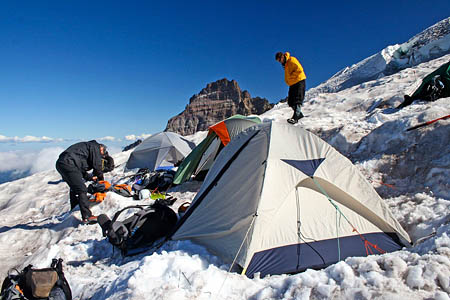
Altitude campers need to take extra care when using heat-exchangers on stoves. Photo Andrew E Larsen. CC-BY-ND-2.0
A mountaineer has warned of the problems of using stoves at altitude after he nearly died due to carbon monoxide poisoning.
Alpine Club member Dave Wynne-Jones was dragged from his tent by fellow climbers after he became unconscious and had to be resuscitated when he stopped breathing.
His companion in the tent, during an expedition to Mongolia, went into a fit and also had to be dragged into the open.
The main problem, he said, was that he was using a heat-exchanger pot on his gas stove, which led to the build-up of the toxic gas inside the tent.
He said: “Very little research has been done into carbon monoxide generation especially at high altitude – ie none! All the work on the levels of CO required to cause unconsciousness are based on sea-level pressure levels and little is known on the levels of CO required to do this at altitude.
“The systems may function perfectly well at altitudes lower than 2,500m and this may encourage a false sense of security.”
Mr Wynne-Jones explained that CO is generated in all flames but the deadly gas, which itself is flammable, is usually burned off, forming harmless CO2.
But if the flame has insufficient oxygen or is cooled by the presence of a cold object – a process known as quenching – the formation of CO2 is stopped and CO is released instead.
Pans with heat exchangers present a larger surface area to the flame, increasing the level of flame quenching, increasing the CO levels. “Heat exchangers do work but there is clearly a price to be paid in terms of potential CO emissions,” he added.
Stoves which spread the flames at an angle are more prone to causing quenching, he said. Another problem mountaineers face when using stoves at altitude is that often they will add too much snow when melting for drinks, causing condensation to form. When a heat exchanger pot is being used, this prevents users wiping this condensation away and again increases quenching of the flame.
Mr Wynne-Jones said on the Alpine Club website: “There is no suggestion that there is anything wrong with these systems, only that serious precautions need to be taken when using them at altitude.”
The oft-repeated advice not to cook inside a tent may not be practicable for high-altitude mountaineers in bad weather.
The British Mountaineering Council suggested that extra care be taken when using heat-exchanger pots on stoves and only to cook inside the tent when absolutely necessary.
Users should ventilate the tent as much as possible and be careful not to melt too much snow. Stoves which have a less quenching effect should be considered and, if possible, have a ‘buddy’ outside the tent keeping an eye on the occupants, ready to pull them into the open air if necessary.
Jay Oram
08 July 2011Well everyone knows to keep a tent well ventilated if you choose to cook inside a tent and all manufacturers don't recommend cooking in a tent. Just keep the tent ventilated and pop outside for a breather if you cook for a while.